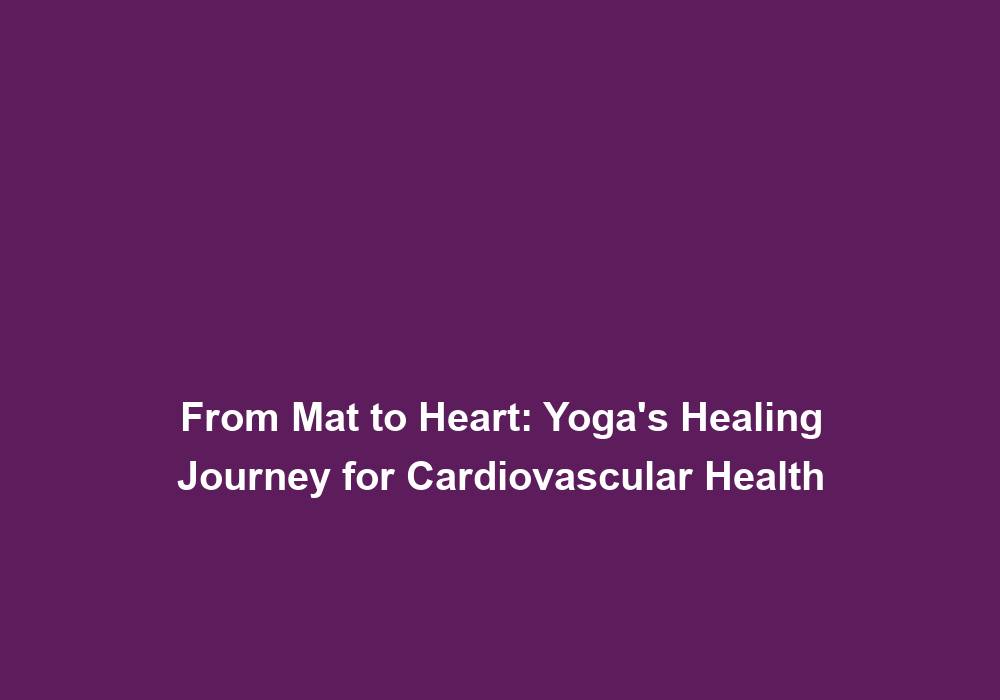From Mat to Heart: Yoga’s Healing Journey for Cardiovascular Health
Yoga is an ancient and profound practice that offers a multitude of benefits for our physical, mental, and emotional well-being. While many individuals engage in yoga for its physical advantages, such as increased flexibility and strength, it also holds immense potential in promoting cardiovascular health. In this article, we will delve into the transformative effects of yoga on our heart health and explore how it positively impacts cardiovascular well-being.
Understanding Cardiovascular Health
Before we embark on exploring the profound impact of yoga on cardiovascular health, it is important to understand the significance of maintaining a healthy heart. The cardiovascular system consists of the heart and blood vessels, working harmoniously to circulate oxygen-rich blood throughout the body. A healthy cardiovascular system plays a vital role in maintaining overall well-being and longevity.
Regrettably, cardiovascular diseases have become increasingly prevalent in modern society, with conditions like hypertension, stroke, and coronary artery disease emerging as leading causes of mortality. Various lifestyle factors, including poor diet, sedentary lifestyle, stress, and obesity, significantly contribute to the development of these diseases.
Yoga as a Path to Heart Health
Yoga is a holistic practice that combines physical postures (asanas), controlled breathing exercises (pranayama), meditation, and mindfulness techniques. Through these various components, yoga offers a comprehensive approach to improving cardiovascular health.
1. Physical Asanas for Heart Health
Specific yoga asanas can directly benefit the cardiovascular system by improving circulation, strengthening the heart muscle, and reducing blood pressure. Let’s explore some asanas that can be particularly beneficial for heart health:
-
Mountain Pose (Tadasana): This foundational pose promotes alignment, balance, and awareness, enhancing overall circulation and reducing stress. By grounding ourselves in this pose, we create a strong foundation for a healthy heart.
-
Forward Fold (Uttanasana): This pose stimulates blood flow to the brain and heart, reducing blood pressure and relieving stress. As we fold forward, we encourage the blood to flow efficiently, nourishing our cardiovascular system.
-
Bridge Pose (Setu Bandhasana): By opening the chest and stretching the spine, this asana improves heart health and enhances lung capacity. It allows us to create space in the chest, enabling the heart to function optimally.
2. Pranayama for Heart Health
Pranayama, or yogic breathing exercises, play a crucial role in promoting cardiovascular health. Deep breathing techniques used in yoga can help reduce stress, lower blood pressure, and improve overall heart function. Let’s explore some pranayama techniques that are particularly beneficial for heart health:
-
Anulom Vilom (Alternate Nostril Breathing): This technique helps balance the flow of energy, calms the mind, and supports heart health by reducing stress and anxiety. By alternating the breath through each nostril, we bring balance to the body and mind, creating harmony within the cardiovascular system.
-
Ujjayi Breathing (Victorious Breath): Often used in conjunction with asanas, this deep and audible breathing technique increases oxygen intake, inducing relaxation and promoting heart health. By engaging the muscles in the throat and creating a gentle sound, we enhance oxygenation and promote a sense of calmness within the heart.
3. Meditation and Mindfulness for Heart Health
Stress is a significant risk factor for cardiovascular diseases, and yoga provides powerful tools to manage and reduce stress levels. Meditation and mindfulness practices cultivate a state of inner calmness and mental clarity, reducing anxiety and promoting emotional well-being. By reducing stress, these practices indirectly benefit heart health and contribute to overall cardiovascular well-being. Here are some meditation and mindfulness techniques that can support heart health:
-
Loving-Kindness Meditation: This practice involves directing loving and compassionate thoughts towards oneself and others. By cultivating feelings of kindness and compassion, we reduce stress and create a positive impact on our heart health.
-
Body Scan Meditation: This practice involves systematically scanning and bringing awareness to different parts of the body, promoting relaxation and stress reduction. By bringing our attention to the sensations in our body, we release tension and create a harmonious environment for our heart to thrive.
4. Lifestyle Modifications and Yoga
In addition to the physical, breathing, and mental aspects of yoga, adopting a yogic lifestyle can further support cardiovascular health. This includes incorporating a well-balanced diet, maintaining a healthy weight, and engaging in regular physical activity. By integrating these lifestyle modifications with the practice of yoga, individuals can significantly reduce the risk of developing cardiovascular diseases. Here are some lifestyle modifications that can be beneficial for heart health:
-
Balanced Diet: Consuming a diet rich in fruits, vegetables, whole grains, lean proteins, and healthy fats supports heart health by providing essential nutrients and reducing the risk of cardiovascular diseases.
-
Maintaining a Healthy Weight: Maintaining a healthy weight through a combination of a well-balanced diet and regular physical activity reduces the strain on the heart and lowers the risk of developing heart-related conditions.
-
Regular Physical Activity: Engaging in regular physical activity, such as yoga, cardiovascular exercises, or any form of movement, strengthens the heart muscle, improves circulation, and enhances overall cardiovascular health.
Conclusion
From its physical asanas to deep-breathing techniques and calming mindfulness practices, yoga offers a comprehensive approach to promote cardiovascular health. By incorporating yoga into our lives, we can strengthen our hearts, reduce stress, and improve overall well-being. Embracing yoga’s healing journey from the mat to the heart can have a profound impact on our cardiovascular health and help us lead a more balanced and fulfilling life.
Note: This article is written in markdown format.







